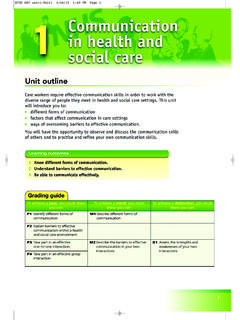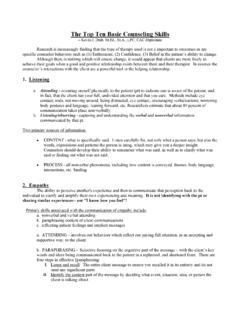Transcription of Communication Skills - OARS? - Provide
1 MM-TI. Miscarriage Management Training Initiative Communication Techniques- OARS. OARS is a skill-based model of interactions adapted from a client-centered approach used in Motivational Interviewing. These skill-based techniques include verbal and non-verbal responses and behaviors. Both verbal and non-verbal techniques need to be adapted to be culturally sensitive and appropriate. OARS stands for: O = Open Ended Questions A = Affirmations R = Reflections S = Summaries As a health care professional it is your role to utilize each of these Skills with intention. To be intentional is the rationale for you to choose a specific response at a specific time.
2 Without intention the health care professional is having a conversation with the patient, but not a professional interaction or intervention. Three reasons for using this skill are: 1. To acknowledge the patient and demonstrate respect which establishes rapport and safety. 2. To help the patient explore and gain information and insight. 3. To challenge the patient to view his or her situation differently or to take alternative action in their decisions. Using OARS will help to establish an atmosphere of acceptance and trust and aid the patient in exploring their hopes and fears. Remember: Open-ended questions, Affirmations, Reflections and Summarizing statements are not used in any order and can be used throughout a patient- provider interaction.
3 Open-ended questions: Are the key to encouraging patients to do most of the talking Cannot be answered with a brief response or a yes or no answer Invite a two-way conversation Begin with words such as how , what or phrases such as tell me more about . Avoid beginning questions with why as that can put patients on the defensive. Miscarriage Management-Training Initiative Johnson-May, VanDerhei, Wallace Examples: What are you most worried about? What will be helpful to you during your visit today? Who have you shared your feelings with? Affirmations: Affirmations give the patient the message that I see you and hear you.
4 May be a compliment or statement of appreciation and understanding Your voice tone, eye contact and body language all can be affirming Reflections: Reflective listening helps make sure that you understand what the patient is telling you You can reflect what is written in a chart, what is said or what you observe It helps the patient hear what she or he said and clarifies any misunderstanding It may be helpful to remember to use a reflection after the patient answers a question. This avoids falling into the question-answer trap.. Summarizing: Is a form of reflective listening Can be used throughout an interaction to transition from topic to topic Can be used at the end of an interaction to review what was discussed Ends with an invitation for patient to respond (What did I miss?)
5 What else would be helpful today? What other questions do you have?). 1. Adapted from: Miller, , Rollnick, S. Motivational Interviewing: Preparing People for Change, 2nd Edition. New York: The Guilford Press, 2002 and PPGNW's Planned Parenthood University, Patient Education Series. Miscarriage Management-Training Initiative Johnson-May, VanDerhei, Wallace2. Communication Techniques continued Sample Questions That Encourage Patient Engagement & Problem Solving 1. Questions that raise alternatives What do you see as possibilities? If you had your choice, what would you do? What if you do ? What if you don't?
6 2. Questions that encourage evaluation How would you feel about that? What do you think is best? In 5 years, how do you think you'll feel about it? 3. Questions that encourage looking at the total picture Tell me a little about your pregnancy? 4. Questions that lead to clarification Help me to understand what you mean. In what ways does this make sense to you? What feels confusing to you about this? 5. Questions that encourage description Tell me more about that. What was that like for you? What happened next? 6. Questions that encourage exploration If you had a choice, what would you prefer to do?
7 What are your options? 7. Questions to identify issues In what way does this bother you? What's the hardest part for you? 8. Questions that encourage the use of information What information do you need in order for you to decide? What do you already know about this? 9. Questions that encourage planning What do you see as the first thing you have to do? Miscarriage Management-Training Initiative Johnson-May, VanDerhei, Wallace3. What are your next steps? What are some other options available to you? Miscarriage Management-Training Initiative Johnson-May, VanDerhei, Wallace4.






